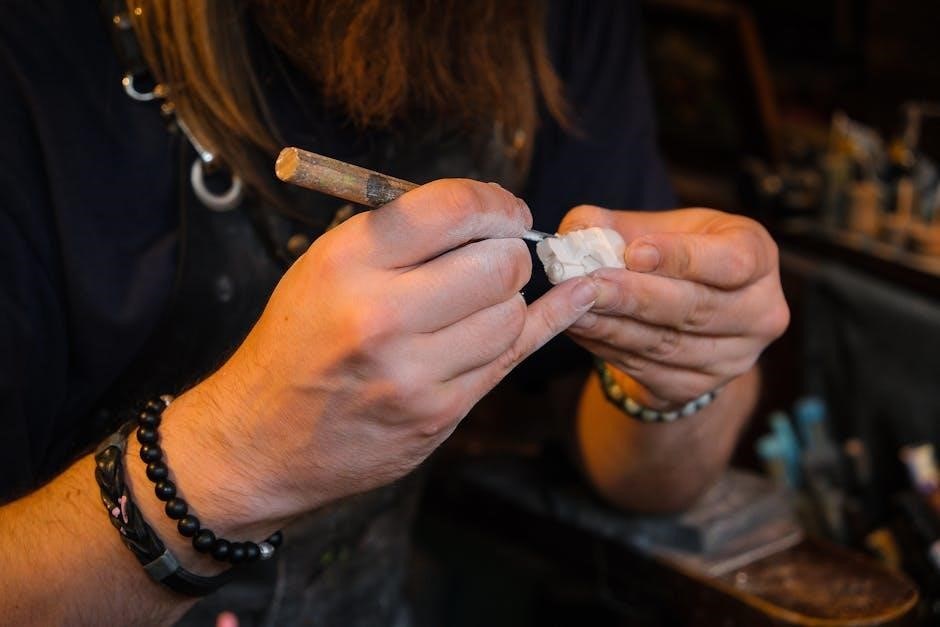Welcome to the comprehensive guide for Craftsman pressure washer instructions․ This guide provides essential information for safe and effective operation, covering setup, usage, and troubleshooting․ Understanding the mechanics ensures optimal performance and longevity․ Follow these steps to master your Craftsman pressure washer․
1․1 Overview of Craftsman Pressure Washers
Craftsman pressure washers are renowned for their reliability, performance, and affordability․ They offer a diverse range of models, from lightweight units for small tasks to heavy-duty machines for industrial use․ Designed for specific tasks and power requirements, these washers empower users to achieve professional-level cleaning results․ Whether for home, yard, or commercial use, Craftsman delivers efficient solutions to meet various cleaning needs effectively․
1․2 Importance of Following Manufacturer Instructions
Adhering to Craftsman’s instructions ensures safe and effective operation․ Proper setup and maintenance prevent equipment damage and guarantee optimal performance․ Compliance with guidelines also protects users from potential hazards associated with high-pressure equipment․ By following the manual, you extend the lifespan of your washer and maintain its efficiency, ensuring reliable results for all cleaning tasks․
Pre-Operation Checklist
Ensure all components are securely connected, check for leaks, verify oil and fuel levels, and inspect hoses for damage before starting the pressure washer․
2․1 Checking the Inlet Filter
Regularly inspect and clean the inlet filter to ensure proper water flow․ A clogged filter can reduce performance and damage the pump․ Remove the filter, rinse it with water, and replace it securely․ If damaged, install a new one․ Always check before use to prevent operational issues and maintain optimal pressure washer efficiency․ Clean filters are essential for consistent performance and longevity of the machine․
2․2 Ensuring Proper Assembly
Before operation, ensure all components are correctly assembled․ Consult the manual for step-by-step guidance․ Cross-reference parts with the inventory list․ Secure hoses tightly and verify connections are leak-free․ Double-check the pump, wand, and spray gun alignment․ Inspect for any visible damage or wear․ Proper assembly ensures safety, performance, and prevents costly repairs․ Test the unit at low pressure to confirm everything functions correctly․

Safety Precautions
Always wear safety goggles and gloves to protect against debris․ Keep children and pets away․ Avoid using the pressure washer near open flames or sparks․ Never operate in enclosed spaces without proper ventilation to prevent carbon monoxide buildup․ Ensure the area is clear of obstacles and flammable materials․ Follow all safety guidelines to minimize risks and ensure safe operation․
3․1 General Safety Guidelines
Always wear safety goggles and gloves to protect against debris․ Keep children and pets away from the operating area․ Avoid using the pressure washer near open flames or sparks․ Ensure proper ventilation when operating in enclosed spaces․ Never point the spray gun at people or animals․ Keep the washer on a stable, level surface to prevent tipping․ Follow all safety guidelines to minimize risks and ensure safe operation․
3․2 Handling High-Pressure Equipment Safely
Always use both hands to hold the spray gun firmly, ensuring control․ Wear protective eyewear and keep loose clothing tied back․ Maintain a safe distance from the surface to avoid ricochet․ Never aim the nozzle at windows, electrical outlets, or people․ Keep the hose away from hot surfaces and sharp objects․ Store the equipment in a dry, secure location when not in use to prevent accidents․
Assembly and Initial Setup
Begin by unpacking and inventorying all parts․ Follow the manual to connect hoses, attach accessories, and ensure proper alignment․ Tighten all connections securely before use․
4․1 Unpacking and Inventory of Parts
Begin by carefully unpacking the pressure washer and all accessories․ Check for any damage or missing items․ Compare the contents with the manual’s inventory list․ Organize parts to ensure nothing is misplaced․ Inspect hoses, nozzles, and other components for proper condition․ This step ensures a smooth assembly process and prevents delays․ Keep the packaging for future storage needs․
4․2 Connecting Hoses and Accessories
Ensure the pressure washer is turned off before connecting any hoses or accessories․ Attach the high-pressure hose to the pump and gun, securing tightly with provided fittings․ Connect the spray lance and nozzles, ensuring they are locked in place․ Double-check all connections for leaks and tighten as needed․ Use Teflon tape on threaded fittings for a watertight seal․ Proper connections ensure safe and efficient operation;

Operating the Craftsman Pressure Washer
Begin by priming the pump and ensuring the machine is on a level surface․ Pull the recoil starter or press the electric start button․ Adjust the spray nozzle according to the surface type and desired pressure․ Use the pressure washer in a steady, sweeping motion for consistent cleaning․ Always maintain proper posture and grip for control․
5․1 Starting the Machine
To start the Craftsman pressure washer, locate the on/off switch or recoil starter․ For electric models, plug in and press the start button․ For gas models, pull the recoil cord firmly․ Ensure the oil level is adequate for gas-powered units․ Prime the pump if necessary․ Always wear safety goggles before starting․ Refer to the manual for specific startup procedures to ensure safe and proper operation every time․
- Ensure all connections are secure․
- Check the oil level for gas models․
- Prime the pump if required․
- Start the engine or motor․
5․2 Adjusting Pressure Settings
Adjusting the pressure settings on your Craftsman pressure washer ensures optimal cleaning for different surfaces․ Locate the pressure regulation knob, typically near the pump or spray gun․ Turn the knob clockwise to increase pressure and counterclockwise to decrease it․ Always start with lower settings to avoid damage, then gradually increase as needed․ Match the pressure to the detergent or spray tip being used for best results․
- Use lower settings for delicate surfaces․
- Higher settings are best for tough stains․
- Adjust based on the spray tip angle․

Choosing the Right Accessories
Selecting the right accessories for your Craftsman pressure washer enhances efficiency․ Opt for nozzles, hoses, and detergents designed for specific tasks to ensure optimal performance and longevity․
- Pick nozzles based on surface type․
- Use detergents for targeted cleaning needs․
- Ensure compatibility with your washer model․
6․1 Nozzles and Spray Tips
Nozzles and spray tips are essential for your Craftsman pressure washer․ The wide fan nozzle is ideal for large surfaces like driveways, while the narrow nozzle tackles tough stains and grout․ Variable nozzles offer adjustable spray angles for versatility․ Color-coded nozzles indicate pressure levels: red for high pressure, wider for lower․ Proper selection enhances cleaning efficiency and prevents surface damage․ Using the wrong nozzle can reduce effectiveness or damage the washer․ Always inspect nozzles for wear and tear before use to ensure safety and optimal performance․
6․2 Detergents and Cleaning Solutions
Using the right detergents and cleaning solutions is crucial for effective cleaning with your Craftsman pressure washer․ Always use manufacturer-approved detergents to avoid damaging the machine or surfaces․ Water-based detergents are ideal for most tasks, while solvent-based options are better for heavy grease․ Avoid household cleaners as they can harm the washer․ Dilute detergents as per instructions and apply with a low-pressure setting to prevent surface damage․ Regularly rinse surfaces thoroughly to remove residue․

Maintenance and Care
Regular maintenance ensures your Craftsman pressure washer performs optimally․ Check the inlet filter, drain hoses after use, and lubricate moving parts․ Refer to the manual for detailed guidance to extend the lifespan of your equipment․
7․1 Routine Maintenance Tasks
Perform routine maintenance by checking and replacing worn seals, lubricating the pump, and inspecting hoses for damage․ Regularly clean the inlet filter and ensure all connections are tight․ Change the oil in gas-powered models every 50 hours of use․ Inspect and replace the high-pressure hose if cracks appear․ Drain and flush the detergent tank after each use to prevent buildup․ Refer to your manual for specific guidelines to ensure optimal performance and longevity of your Craftsman pressure washer․
7․2 Winterization and Storage
Winterize your Craftsman pressure washer by draining all fluids, including fuel and water, to prevent freezing․ Use a pump saver kit or antifreeze to protect the pump․ Store the unit in a dry, secure location away from direct sunlight․ Inspect hoses for damage and coil them neatly․ Disconnect and store accessories separately to maintain their condition․ Follow these steps to ensure your washer remains in good shape during the off-season․

Troubleshooting Common Issues
Identify and resolve issues like low pressure, no spray, or engine problems․ Check for blockages, worn seals, or faulty valves․ Restart the machine and ensure proper oil levels for smooth operation․ Refer to the manual for detailed diagnostic steps and solutions to maintain performance and longevity․
8․1 Low Pressure or No Spray
Low pressure or no spray can occur due to clogged nozzles, blocked inlet filters, or incorrect pressure settings․ Clean or replace the nozzle and filter․ Ensure the pressure regulator is adjusted properly․ Check for kinks in hoses and tighten connections․ If issues persist, inspect the pump for wear or damage․ Regular maintenance can prevent these problems and ensure optimal performance․ Always refer to the manual for specific guidance․
8․2 Engine or Motor Problems
Engine or motor issues may arise from overheating, low oil levels, or faulty spark plugs․ Regularly check oil levels and ensure proper ventilation․ Inspect spark plugs for damage or fouling․ If problems persist, consult the user manual or contact Craftsman support․ Addressing these issues promptly can prevent damage and extend the lifespan of your pressure washer․ Always follow maintenance schedules․

Advanced Tips for Effective Cleaning
Optimize results by adjusting pressure settings for different surfaces․ Use wide-spray nozzles for large areas and narrow tips for tough stains․ Work in sections to maximize efficiency and avoid missing spots․ Regularly inspect and clean nozzles to ensure proper water flow․ Always maintain a consistent distance from surfaces for even cleaning․ This ensures better outcomes and prolongs equipment life․
9․1 Techniques for Different Surfaces
Use lower pressure for delicate surfaces like wood and higher pressure for concrete․ Adjust nozzle angles to avoid damage—wide for large areas, narrow for stubborn stains․ For siding, keep the nozzle moving to prevent gouging․ On decks, work in the direction of the wood grain to maintain integrity․ Always test pressure on a small area first to ensure safety and effectiveness․
9․2 Using the Correct Spray Angle
Adjust the spray angle based on the surface type․ A wider angle (25°–40°) is best for large areas and delicate surfaces, while a narrower angle (15°–0°) tackles tough stains․ Keep the nozzle 12 inches away to avoid damage․ Move steadily, overlapping paths slightly for even cleaning․ Test different angles on a small area first to ensure optimal results without surface damage․

Environmental Considerations
Adopt eco-friendly practices to minimize environmental impact․ Use water efficiently, choose biodegradable detergents, and dispose of waste properly․ Regular maintenance prevents chemical leaks and ensures sustainable use․
10․1 Reducing Water Usage
Minimize water consumption by using the correct nozzle size and pressure setting for the task․ Avoid unnecessary spraying and fix leaks promptly․ Utilize low-flow settings for lighter cleaning jobs․ Regularly inspect hoses and connections to prevent water waste․ Educate yourself on water-saving techniques to reduce environmental impact while maintaining effective cleaning results with your Craftsman pressure washer․
10․2 Eco-Friendly Cleaning Practices
Adopt eco-friendly practices by using biodegradable detergents and minimizing chemical use․ Opt for pressure washer models with eco-mode settings to reduce energy consumption․ Regularly maintain the washer to prevent leaks and waste․ Use water-efficient nozzles and avoid unnecessary spraying․ Dispose of wastewater responsibly and clean on permeable surfaces to reduce runoff․ These practices promote sustainability while effectively cleaning with your Craftsman pressure washer․

Warranty and Support
Craftsman pressure washers come with a limited warranty covering defects in materials and workmanship․ For service, contact customer support with your serial number and purchase details․Refer to the warranty terms for exclusions and limitations․
11․1 Understanding the Warranty Offered
Craftsman pressure washers are backed by a limited warranty, typically covering parts and labor for a specified period․ The warranty duration varies by model, with most ranging from 2 to 5 years․ Registration may be required to activate coverage․ Understanding the terms, including what is covered and excluded, ensures proper maintenance and avoids potential disputes․ Always review the warranty document provided with your purchase․
11․2 Contacting Customer Support
To contact Craftsman customer support, visit their official website for phone, email, and live chat options․ Have your model number and purchase details ready for efficient assistance․ Support is available to address questions, troubleshooting, or warranty claims․ For quicker resolution, ensure all information is accurate and readily available before reaching out․

User Manual and Documentation
The user manual provides essential information for safe and effective operation․ It includes safety guidelines, setup instructions, usage tips, maintenance schedules, troubleshooting guides, and warranty details․
12․1 Downloading the Official Manual
To access the official Craftsman pressure washer manual, visit the manufacturer’s website․ Navigate to the support or downloads section, enter your model number, and download the PDF․ Ensure it’s from a trusted source for accuracy․ The manual covers safety, assembly, operation, and maintenance․ Save or print it for easy reference during setup and troubleshooting․
12․2 Navigating the Manual Sections
The manual is organized into clear sections for easy navigation․ Start with the table of contents to locate specific topics like assembly, operation, or troubleshooting․ Use the index for quick access to terms or procedures․ Each section includes detailed instructions, diagrams, and safety tips․ Familiarize yourself with key areas like safety guidelines, maintenance schedules, and warranty information to ensure proper usage and care of your Craftsman pressure washer․
FAQs
Q: How often should I maintain my pressure washer? Regular maintenance, like checking hoses and filters, ensures optimal performance and longevity․
13․1 Common Questions from Users
Q: What is the ideal PSI for cleaning different surfaces? For siding, use 1200-1500 PSI; driveways need 2000-3000 PSI․ Adjust based on surface type to avoid damage․
Q: Can I use any detergent in my pressure washer? Only use manufacturer-recommended detergents to prevent damage to the pump or hoses․
Q: Why is my pressure washer losing pressure? Check for clogged nozzles, kinked hoses, or a faulty inlet filter․ Ensure all connections are secure․
Q: How do I store the washer during winter? Drain all water, add a pump saver, and store in a dry, protected area to prevent freezing damage․
Q: Can I repair the washer myself? Minor repairs like replacing seals or hoses are possible, but complex issues may require professional service․
13․2 Answers to Frequently Asked Questions
How do I achieve the best cleaning results? Use the correct nozzle for the job, maintain a consistent distance from surfaces, and avoid using excessive pressure that could cause damage․
Can I use a pressure washer on windows? Yes, but use a low-pressure setting (600-800 PSI) and a wide fan tip to avoid breaking glass or damaging seals․
Why does my washer have low pressure? Check for blockages in the nozzle, ensure the water supply is adequate, and verify that all hoses are properly connected without kinks․
How often should I maintain my washer? Perform routine checks on the inlet filter, oil levels, and hoses monthly․ Replace worn parts promptly to prevent breakdowns․
Is it safe to use in cold weather? Avoid using your pressure washer in freezing temperatures to prevent damage to the pump and hoses․ Winterize the unit if storing in cold conditions․
By following these instructions, you’ll optimize your Craftsman pressure washer’s performance, ensuring efficient cleaning and longevity․ Proper maintenance and safe operation are key to lasting satisfaction․
14․1 Summary of Key Points
Proper assembly, pre-operation checks, and safe handling are crucial for optimal performance․ Regular maintenance, such as cleaning filters and storing correctly, extends the lifespan․ Always use recommended accessories and follow safety guidelines to avoid accidents․ Efficient cleaning techniques and eco-friendly practices ensure effective results while minimizing environmental impact․ Adhering to the manual ensures reliability and satisfaction․
14․2 Final Tips for Optimal Use
Always test pressure settings on a small area first to ensure they’re suitable for the surface․ Use the correct nozzle for the job to maximize efficiency․ Keep the spray gun moving to avoid concentrating pressure on one spot․ Regularly inspect hoses and connections for wear․ Refer to the manual for specific guidelines tailored to your model․
Additional Resources
Visit the manufacturer’s official website for detailed manuals and troubleshooting guides․ Explore video tutorials on platforms like YouTube for practical demonstrations․ Join forums for user tips and advice․
15․1 Online Tutorials and Videos
Explore official Craftsman YouTube channels and websites for step-by-step tutorials․ These videos cover assembly, operation, and troubleshooting․ Additionally, third-party forums and DIY websites offer practical tips and user experiences․ Watching these can enhance your understanding and improve cleaning efficiency․ Many tutorials also focus on specific models, ensuring relevance to your pressure washer․ Utilize these resources for visual guidance and troubleshooting assistance․
15․2 Community Forums and Discussions
Join online forums dedicated to Craftsman pressure washers to connect with other users․ These platforms offer valuable insights, troubleshooting tips, and advice from experienced owners․ Discussions often cover common issues, maintenance tips, and accessory recommendations․ Many communities also share DIY modifications and creative uses for pressure washers․ Engaging with these groups can provide personalized solutions and enhance your overall experience with the product․
Final Thoughts
Regular maintenance and proper usage ensure optimal performance and longevity of your Craftsman pressure washer․ Always follow guidelines for safe operation and storage to maximize efficiency and effectiveness․
16․1 Maximizing the Lifespan of Your Washer
Proper storage, regular maintenance, and avoiding excessive pressure are key to extending your Craftsman pressure washer’s lifespan․ Store it in a dry place, protect hoses from damage, and use manufacturer-recommended parts․ Regularly inspect and replace worn components to ensure optimal performance and longevity, adhering to the guidelines outlined in the user manual․
16․2 Staying Informed About Updates
Regularly check the official Craftsman website for firmware updates, new features, or safety notices․ Register your pressure washer to receive email notifications about updates․ Subscribe to newsletters or follow official social media channels for the latest information․ Download updated manuals or guides to stay current with best practices and product enhancements․

